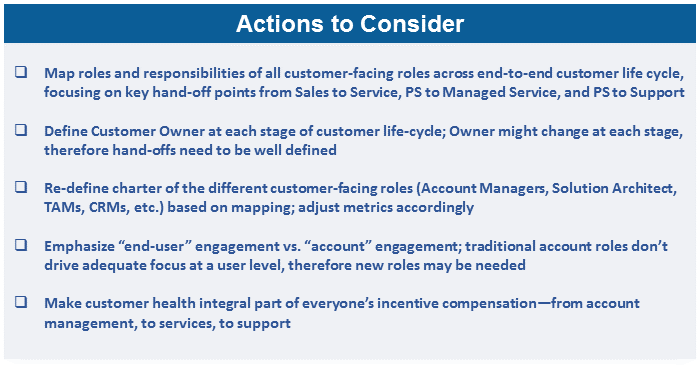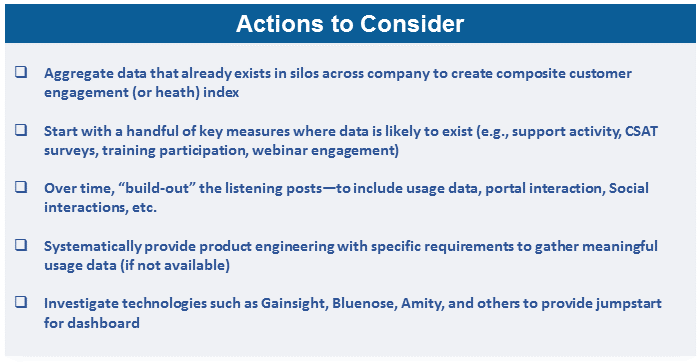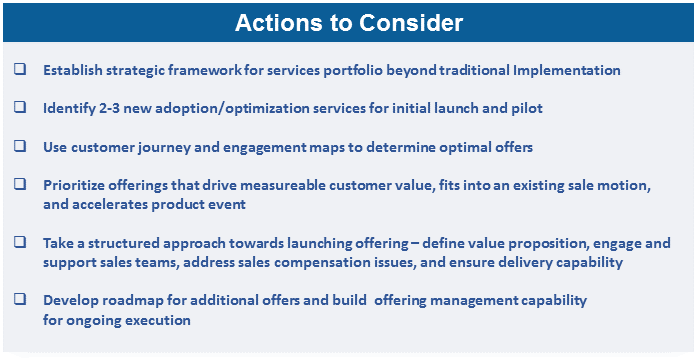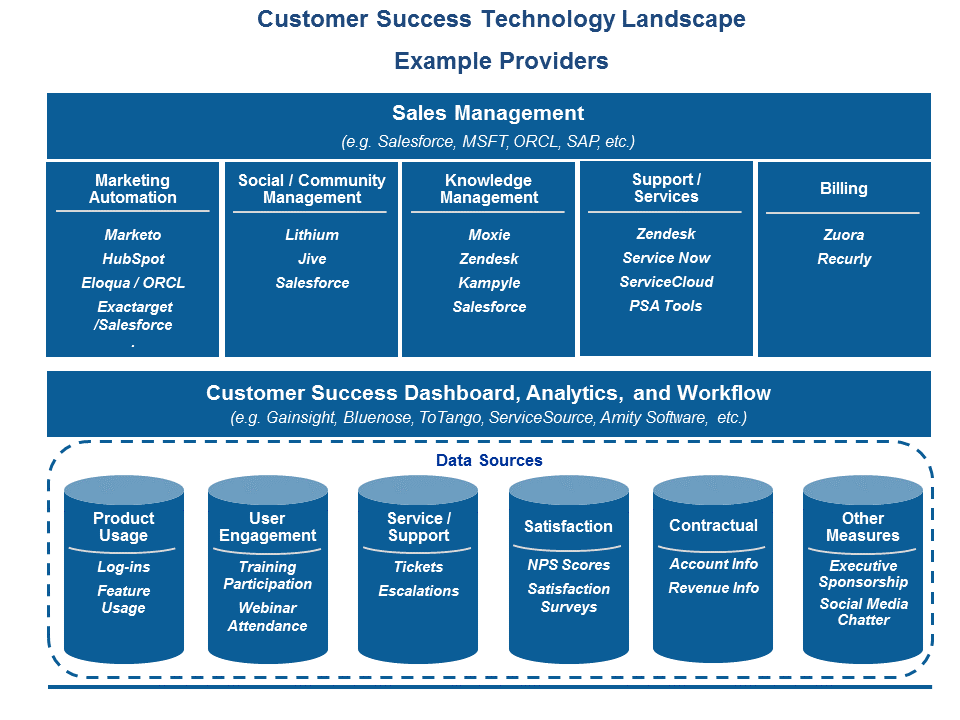Customer success has always been important for enterprise software providers. But over the past year, the tenor around customer success has taken on an increased sense of urgency. Over 70 percent of top software providers have stated that customer success is a priority (based on Waterstone analysis of the top 20 software companies’ customer experience and success initiatives, including organizational announcements, job postings, new offerings, etc.), and providers like Informatica are anointing new customer success organizations and/or chief customer officers. For anyone at Dreamforce ’14, it was hard to miss the customer success drumbeat. LinkedIn currently lists more than 35,000 job postings for customer success managers.
Software providers’ increased attention to customer success is not surprising for two primary reasons:
- The economics are compelling as software providers and customers alike increasingly adopt the “as-a-Service” subscription model. As an example, a five-point reduction in churn rate often yields a revenue increase of 20 percent in year five (modeled for a $100M company; all other assumptions are equal).
- Customer expectations are changing. Customers — with expectations founded in their experiences with more intuitive consumer technology that have customer interactions “built in” — are upending traditional norms of provider-customer interactions.
Today, customers want their products ready for use faster, they want to pay for only what they use, they want help when they need it and they want to derive real value from the products.
The definition of what constitutes customer success is broad. In our view, it is to ensure that users adopt the technology and are able to quickly and measurably derive value from it. While the definition is simple, the transformation required to ensure success is significant and touches on all aspects of the post-sale customer interaction, from account management, professional services (PS) and support to renewals and upsell.
Four priorities to drive customer success
Despite all recent buzz and activity around customer success, software executives still struggle to get started — deciding how to apply customer success within their company and getting initiatives funded and launched.
To assist software providers on their journey to become more customer-centric, Waterstone has outlined practical advice around four key customer success priorities that providers should execute on immediately.
1. Integrate the post-sale customer experience
As product portfolios have become increasingly diverse and complex, so too have customer engagement models. Growth of product SKUs, M&A, multiple deployment options (on premises, SaaS, dedicated hosted), and standalone support and service offers contributed to nuanced customer engagement models and, often, a fragmented customer experience.
The charter and accountabilities of the various customer-facing roles are not clearly defined, including those for account managers, technical account managers (TAMs), customer success managers, PS engagement managers, renewal specialists, etc. In our experience, while enterprise software providers are investing in these roles, they are still delivering a fragmented customer experience.
Mapping end-to-end customer workflows and specifying the responsibilities and hand-offs across the various roles are both integral to delivering a completely integrated customer experience. Such mapping has implications on organizational structure, including where these roles reside and the metrics by which they are measured.
 2. Gain a deep understanding of your customer (and users)
2. Gain a deep understanding of your customer (and users)
Knowledge of your customers’ business drivers is a prerequisite to driving their success. That said, capturing your customers’ Key Performance Indicators (KPIs), measuring them and monitoring the impact that your solution has on them is challenging. As a starting point, providers should at minimum leverage available product usage, adoption, engagement and referral metrics as a proxy for success. A user who is engaged, using your product, adopting more of it and promoting it to others is likely getting value.
The good news is that there are a number of listening posts that providers can mine to get a 360-degree view of their customers. These include sales calls, support interaction, marketing webinars, user forums, training participation, Net Promoter Score (NPS) surveys, social chatter, executive meetings, product usage data, etc. Furthermore, a number of technology platforms recently emerged to help gather these metrics, create sophisticated customer success dashboards and enable workflows to improve customer experience, reduce churn risk and drive upsell.
In our experience, providers tend to under-leverage these listening posts, hampering their ability to truly “know” their customers. Providers should invest in efforts to get a comprehensive view of their customers; using NPS alone is not sufficient.
 3. Reinvigorate the professional services portfolio
3. Reinvigorate the professional services portfolio
Traditionally, the majority of services revenue for an enterprise software company is generated by the implementation of its core products. Today, providers are under intense pressure from customers to implement their solutions more quickly and economically. To respond to this demand, providers must take a hard look at all their processes to identify opportunities to automate and accelerate service delivery.
In parallel, enterprise software providers should consider offering more product-independent (but related) services to compensate for the decrease in core implementation services. Such services can include revitalization, adoption, optimization and value realization services. These services not only drive product-independent services revenue, but they also play an instrumental role in ensuring customers adopt more of the product and derive value from it. The difficulty most enterprise software providers face is that the operating model to launch, scale, sell, and deliver these services is not well established.
 4. Drive scale through enhanced technology
4. Drive scale through enhanced technology
While putting in place an effective customer success capability is important, the ability to scale effectively and efficiently is essential. There are three areas where technology will play a key role in enabling scale:
- Use of customer analytics and dashboards to assess engagement and satisfaction levels, predict renewal risk, identify upsell and cross-sell opportunities, and prioritize support, marketing, or sales activity
- Workflow automation to orchestrate end-to-end customer engagement across the different teams
- Tech-touch engagement with users to enable targeted one-to-many outreach, including profile-based outbound marketing, customer community management, social engagement, etc. Predictive analytics can also be used to profile usage patterns and tailor outreach and content.
Below is an overview of the current customer success technology landscape and an example list of platforms that play a role in enabling customer success. It is imperative that software providers define their technology strategy to achieve scale in delivering customer success.

The time for action is now
Customer success is top of mind throughout the software industry for a reason. The industry’s shifting market dynamics compel company leaders to reevaluate their business models to be successful. Providers that act now in implementing a thoughtful, integrated approach to customer success will be well positioned to identify and capitalize on new revenue and growth opportunities.
Dhaval Moogimane is a partner at Waterstone Management Group, a strategy consulting firm that works exclusively with investors and management teams of technology companies. Dhaval focuses on helping clients create measureable value by identifying and capitalizing on disruptive growth opportunities and by driving excellence in services, cloud and customer success performance.
